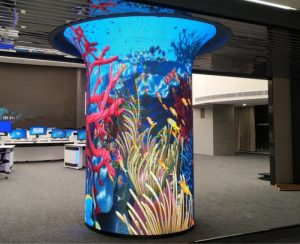Seamless LCD technology as a high demand, high-level projection display application, the specific operation is: fusion of multi screen images, while reducing the gap between stitching seams, or make stitching seams overlap. On the one hand, in the application of seamless splicing technology, we need to prepare a wide screen; on the other hand, we must ensure that the size of the projection used meets the working standard. Different from BSV liquid crystal splicing technology, the gap of seamless splicing technology is relatively small.
From the perspective of its development process, seamless splicing technology has gone through three stages, namely pure hardware fusion technology, pure software fusion technology and software hardware fusion technology. The so-called pure hardware fusion technology mainly refers to the use of optical shading principle to fuse a variety of images together. The pure software fusion technology uses electronic circuits to process images. As the name suggests, hardware and software fusion technology is a combination of the above two technologies, which includes both optical shading fusion technology and electronic fusion technology. Compared with the former two technologies, its display effect is relatively good. This is because the hardware fusion technology can solve the problem of black balance in the process of image processing, while the software fusion technology has a positive effect on the processing of image white balance. The two technologies complement each other and can enhance the authenticity of the reconstructed image.
According to the analysis of its splicing effect, seamless splicing technology also goes through three processes, namely hard edge splicing, overlapping splicing and soft edge fusion splicing. In the process of applying the hard edge stitching technology, it is inevitable that there are some seams, which lead to many shortcomings in panoramic reproduction; overlapping stitching refers to using two projectors to superimpose the projected images at the splicing place, so as to achieve the effect of overlapping. Compared with the hard edge splicing technology, this splicing technology has many advantages, but also has some limitations. This mosaic method may cause the display screen to appear too bright area because of the excessive number of images superimposed. In this way, the application of seamless technology will be adversely affected. The edge fusion technology is used for image fusion. This not only makes the two sides merge better, but also effectively prevents the over bright area. In addition, the soft edge fusion stitching technology has a wide range of applications, such as planar, cylindrical, spherical and so on. Highway seamless LCD technology makes full use of this advantage to provide guidance for highway engineering construction.



